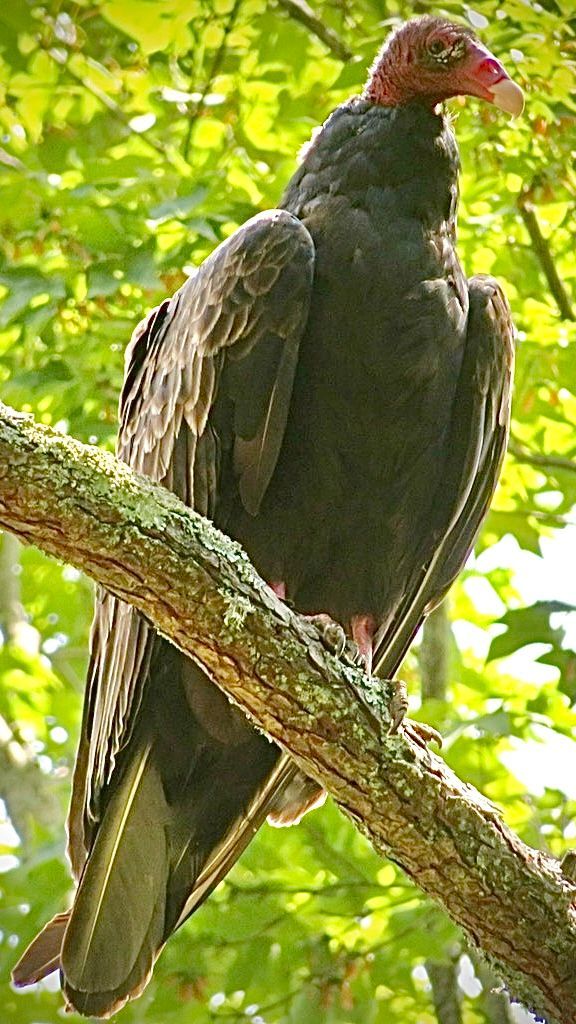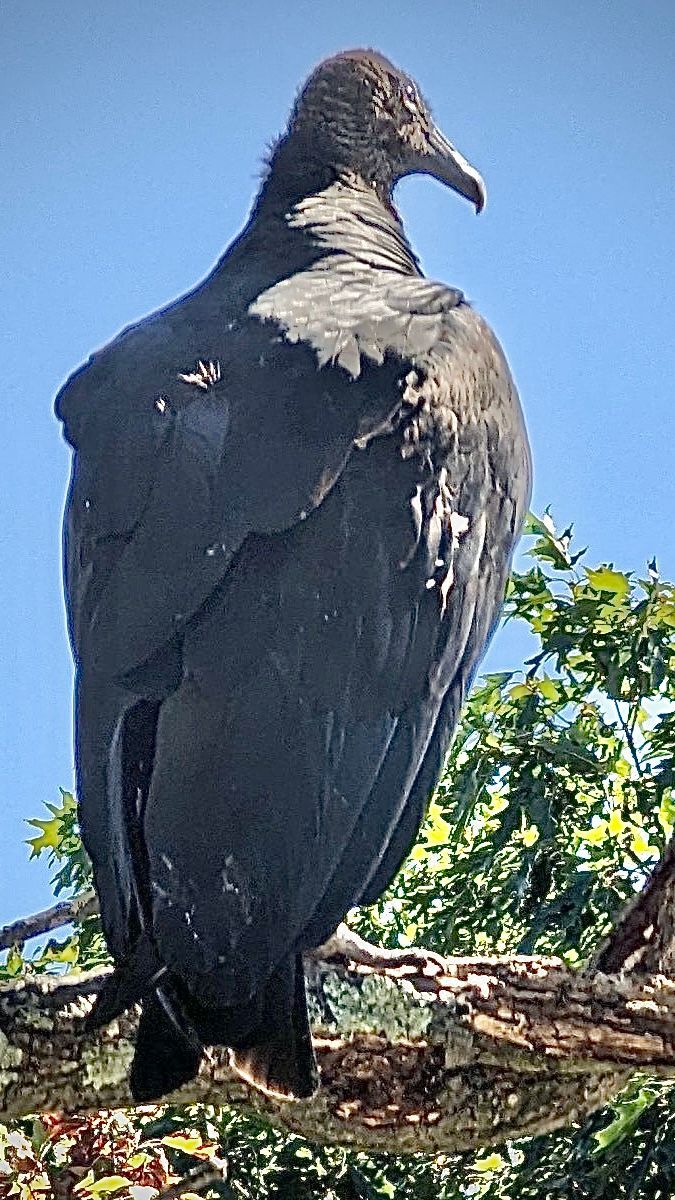"What on Earth?"
Article by Ray Barbehenn. Photos by David Cox, Richard Stromberg and Ray Barbehenn
Vultures live quiet, conservative lives, rarely uttering a sound and soaring as much as possible without flapping their wings. They are like living kites. But, compared with the majestic eagles, hawks, and owls, they seem to get little respect. Their association with death and their naked heads are unattractive to us.
There are two vulture species in the eastern United States: the Turkey Vulture and the Black Vulture. In our area, Turkey Vultures are more commonly seen, though usually at great distances. The left photo shows a close observation made by David Cox on August 16, 2017 in the foothills of SNP. It shows the red, featherless skin on its head and neck for which it is named. From a distance, you can identify them by the upward, V-shape in which they hold their wings. The Black Vulture in the right photo was seen by Richard Stromberg in Catoctin Mountain Park on October 11, 2023. It has a black bare head, black feathers, and a shorter, broader tail compared to that of the Turkey Vulture. Like hawks, Black Vultures hold their wings flat while they soar. Both vultures pictured here were sunning themselves at their roosts. As the air warms in the morning, they ride updrafts ("thermals"), gaining elevation effortlessly to search the countryside for a carcass.
How can vultures eat dead animals without getting sick?
A. "Good" gut bacteria.
B. An active immune system.
C. Strong stomach acid.
D. All of the above.
E. Unknown.
The answer is at the bottom of the page!
Fun Facts and Musings
A variety of toxic bacteria grow in carrion, including those that cause botulism (food poisoning) and gas gangrene. These bacteria probably produce their poisons to compete with each other and to try to ward off hungry animals, since their stomachs are harsh environments. As they feast, bacteria also produce the odors of death–the odors that attract vultures.
Although vultures are attracted to these odors, they actually prefer to eat recently dead animals. Thus, there seems to be a Goldilocks state for carrion: too fresh, and vultures cannot smell it, but too rotten, and even vultures will pass it by. They like their meat quite rare, and with just a hint of odor, please.
We mainly notice vultures when they are feeding at road kills, but Turkey Vultures also eat a variety of small dead animals, such as rodents and snakes. On rare occasions, Black Vultures will prey on live animals. This has given them a bad reputation in farming areas, where the loss of a young farm animal is not readily overlooked. By comparison, Turkey Vultures appear to only eat dead animals.
Turkey Vultures and Black Vultures have surprisingly different abilities to find their food. Turkey Vultures have an outstanding ability to smell carcasses, while Black Vultures rely mainly on their vision. The superior sense of smell of Turkey Vultures gives them the ability to detect food that is hidden from view beneath the canopies of leaves in forests.
This powerful sense of smell in Turkey Vultures can be seen in the structure of their skulls: they have huge, oval-shaped nostrils just behind the tips of their beaks! You can see this in the bottom photo, which compares a a Turkey Vulture's skull (front) with that of a visual hunter, the Red-tailed Hawk (back). Not surprisingly, the skulls of Black Vultures have much smaller nostrils than those of Turkey Vultures.
The air taken in through their nostrils passes back into their large nasal passageways, which are packed with huge numbers of odor receptors (these are specialized nerve endings that fire signals to the brain when certain odor molecules strike them). Thus, Turkey Vultures are the bird equivalents of dogs and bears, whose elongated snouts also contain huge numbers of odor receptors.
The final component of the Turkey Vulture odor detection system is in their brains: An extremely large portion of their brains is devoted to processing the information about smells. Indeed, Turkey Vultures have the largest fraction of their brains devoted to smell of any bird! Even compared to Black Vultures the "olfactory bulbs" in the brains of Turkey Vultures are four times larger.
Given their superior sense of smell, as well as their good vision, Turkey Vultures are usually the first to find a carcass. By contrast, Black Vultures have been observed following Turkey Vultures to share their food. It is often repeated that Black Vultures are aggressive towards Turkey Vultures at carcasses. However, recent research using game cameras placed at carcasses showed that Black Vultures are actually much more aggressive towards each other than they are towards Turkey Vultures. Black Vultures are gaining in numbers in our area, and large numbers of them sometimes do overwhelm the Turkey Vultures at a carcass. You can imagine the strong competition for a meal at a carcass when a flock of vultures has landed!
So, how
do vultures resist getting sick from their food? The three major possibilities ("good" bacteria in their guts, active immune systems, and highly acidic stomachs) are probably all important. Hundreds of species of harmful and potentially beneficial bacteria have been identified in the stomachs of vultures (and these are just a fraction of the ingested species that are able to tolerate the harsh conditions in a vulture's stomach). However, it is not yet known whether the "good" bacteria actually protect the health of vultures.
Likewise, there are hints that vulture immune systems are important for their protection from infection, but the research has just begun. Finally, it is commonly believed that vultures have unusually acidic stomachs. No doubt, their acidic stomachs play an essential role in killing most of the bacteria in the food that they eat. Just as in humans, this is their first line of defense against becoming sick from contaminated food. But is the stomach acid of a vulture far stronger than ours? Apparently not. Recent research showed that the stomach contents in actively feeding Turkey Vultures and Black Vultures has a similar range of acidity (pH) as ours, with the lower range of about pH 2 (pH 2 is equivalent to the acidity of vinegar).
Thus, vultures appear to "pickle" their food in a similar fashion as most other vertebrate animals. It is frustrating to find that most of what you can read about these topics is based on just a handful of recent scientific studies and centuries of anecdotes and speculation.
While vultures are high in the sky, it is difficult for us to recognize their social interactions. Male and female Turkey Vultures (and probably Black Vultures) bond for life. So, the next time you see a couple of soaring vultures, you can imagine that they are probably husband and wife, sharing a life-long devotion to each other to raise their young and, yes, dine together on stinky food.
Answer: D is a very good guess, but right now it's E! More research is needed on vultures.
Send your photos and ideas for topics to Ray at
rvb@umich.edu
(I am looking for anything "normal" that you think is interesting and have a good photo of).



